Exhibits - Palace of Agriculture: Difference between revisions
No edit summary |
No edit summary |
||
| (23 intermediate revisions by the same user not shown) | |||
| Line 1: | Line 1: | ||
{{SHORTDESC:Exhibits - Palace of Agriculture}} | {{SHORTDESC:Exhibits - Palace of Agriculture}} | ||
Exhibits located within the Palace of Agriculture | Exhibits located within the [[Palace of Agriculture]] were classified under [[Fair Classifications#Department H: Agriculture|Department H]]. | ||
__NOTOC__ | __NOTOC__ | ||
{{#display_map: | {{#display_map: | ||
| image layers=FP-Palace of Agriculture.jpg | | image layers=FP-Palace of Agriculture.jpg | ||
| geojson = PalaceOfAgriculture | | geojson = PalaceOfAgriculture | ||
| zoom= | | zoom=3 | ||
| maxzoom =6 | | maxzoom =6 | ||
| minzoom= | | minzoom=2 | ||
| cluster=yes | | cluster=yes | ||
| copycoords=yes | | copycoords=yes | ||
| fullscreen=true }} | | fullscreen=true }} | ||
__TOC__ | __TOC__ | ||
==Domestic== | ==Domestic== | ||
===California=== | ===California=== | ||
The state of California had several exhibits in the Agriculture Palace that featured the diversity of agriculture in that state. One of these was the Santa Clara County exhibit where free prunes were given out; the purpose of which was to educate | [[File:Agriculture- California - Bear.jpg|200px|thumb|Bear made of Prunes.]] | ||
'''Blocks [80, 81, 82, 83, 84]''' - The state of California had several exhibits in the Agriculture Palace that featured the diversity of agriculture in that state. One of these was the Santa Clara County exhibit where free prunes were given out; the purpose of which was to educate passerbys on the proper methods of cooking prunes and the value of dried fruits. News spread fast of the prunes causing daily supplies to be entirely depleted by noon. The exhibit was made under direction of the San Jose Chamber of Commerce and was maintained by Mr. Lloyd Childs. | |||
There was also an impressive model of an old mission church in Santa Clara County. The arches of the church were lined with prunes and solid squares of peaches, and the corners were made of apricots. | There was also an impressive model of an old mission church in Santa Clara County. The arches of the church were lined with prunes and solid squares of peaches, and the corners were made of apricots. A state seal was made of beans. | ||
Over three hundred varieties of wines, champagnes and brandies were shown here by the California Wine Growers. The Wine Temple was 33' high and covered 3,000 square feet. Garlands of grape vines with large bunches of grapes decorated the temple. Thirty five of the leading vineyards in California were represented. California was predicting that it would become the vineyard of the world. | |||
The great elephant made from Almonds was not in the Palace of agriculture. It was in the California exhibit in the [[Palace of Horticulture]]. | The great elephant made from Almonds was not in the Palace of agriculture. It was in the California exhibit in the [[Palace of Horticulture]]. | ||
California also showed a bear made from prunes. Complete with a red light in it's mouth it, their was a prize challenge to guess how many prunes made up the bear. | |||
===Colorado=== | ===Colorado=== | ||
The Colorado exhibit featured the Greeley Irish potato. It is an unusually large and fine variety, with a yield of six hundred bushels an acre. Colorado’s atmosphere and soil is the key to the potato’s size and flavor. If planted anywhere else, these qualities are lost. The Greeley product was a very profitable crop, for example, J. A. Haythorne of Eaton made $9,967 (${{Format price|{{Inflation|US|9,967|1904}}}} in {{Inflation/year|US}}) from seventy acres. | '''Block [91]''' - The Colorado exhibit featured the Greeley Irish potato. It is an unusually large and fine variety, with a yield of six hundred bushels an acre. Colorado’s atmosphere and soil is the key to the potato’s size and flavor. If planted anywhere else, these qualities are lost. The Greeley product was a very profitable crop, for example, J. A. Haythorne of Eaton made $9,967 (${{Format price|{{Inflation|US|9,967|1904}}}} in {{Inflation/year|US}}) from seventy acres. | ||
===Idaho=== | ===Idaho=== | ||
The Idaho booth featured peacocks made of grain. | [[File:Agriculture- Idaho.jpg|200px|thumb|Idaho Exhibit Entrance]] | ||
'''Block [62]''' - The Idaho booth featured peacocks made of grain. | |||
===Illinois=== | ===Illinois=== | ||
The Illinois exhibit featured corn that was worth $10 an ear, produced from the Otwell plan. A South American farmer offered $10 each, for the best 10 ears of corn. W. B. Otwell sent 500 grains of pedigree seed to 8,000 farm boys in Illinois, and 1,700 of them sent 10 ears each to Mr. Otwell to be placed in the exhibit. Corn from every county in the state was sent to be in the exhibit. A $3,500 premium was placed on the corn, and the farm boy with the best corn won $500. At the exhibit the 10 ears that each farm boy sent were in a stack with the his picture was on display in front of it. Mr. Otwell received many letters from farm boys that could not come to the fair with excuses such as, the mules got out and ate the corn or mother picked the wrong corn for roasting. Illinois was the only state that had a contest and exhibit of this kind. | [[File:Agriculture- Illinois - Boys Corn.jpg|200px|thumb|Illinois Boys Corn Display]] | ||
'''Blocks [47,48]''' - The Illinois exhibit featured corn that was worth $10 an ear, produced from the Otwell plan. A South American farmer offered $10 each, for the best 10 ears of corn. W. B. Otwell sent 500 grains of pedigree seed to 8,000 farm boys in Illinois, and 1,700 of them sent 10 ears each to Mr. Otwell to be placed in the exhibit. Corn from every county in the state was sent to be in the exhibit. A $3,500 premium was placed on the corn, and the farm boy with the best corn won $500. At the exhibit the 10 ears that each farm boy sent were in a stack with the his picture was on display in front of it. Mr. Otwell received many letters from farm boys that could not come to the fair with excuses such as, the mules got out and ate the corn or mother picked the wrong corn for roasting. Illinois was the only state that had a contest and exhibit of this kind. | |||
===Indiana=== | ===Indiana=== | ||
The Indiana exhibit featured the grains of that state | [[File:Agriculture- Indiana.jpg|200px|thumb|Indiana's Exhibit]] | ||
'''Block [41]''' - The Indiana exhibit featured the grains of that state. | |||
===Iowa=== | ===Iowa=== | ||
'''Block [59]''' -The Iowa exhibit featured a golden ear of corn with silver husks, silver cups, and other trophies. The golden ear was the prize for the best corn from an Iowa corn club. A corn club was made up of four neighboring farmers. Six ears of corn were picked from each club as an entry. The ears were judged at the farmers’ institute. | |||
The Iowa exhibit featured a golden ear of corn with silver husks, silver cups, and other trophies. The golden ear was the prize for the best corn from an Iowa corn club. A corn club was made up of four neighboring farmers. Six ears of corn were picked from each club as an entry. The ears were judged at the farmers’ institute. | [[File:Agriculture - Iowa.jpg|200px|thumb|Iowa Pavillion]] | ||
Iowa’s exhibit dealt with the introduction of creameries to the west and showed a model of the dairy school at the College of Agriculture at Ames, Iowa. It also showed a bust of John Stewart a pioneer in the dairy industry west of the Mississippi. It also included a model of the first creamery at Manchester, Delaware County, Iowa. | Iowa’s exhibit dealt with the introduction of creameries to the west and showed a model of the dairy school at the College of Agriculture at Ames, Iowa. It also showed a bust of John Stewart a pioneer in the dairy industry west of the Mississippi. It also included a model of the first creamery at Manchester, Delaware County, Iowa. | ||
| Line 46: | Line 51: | ||
===Kansas=== | ===Kansas=== | ||
The Kansas Display featured Wheat and other grains grown in Kansas. H. H. Kern, was Superintendent of the Kansas Exhibit and he wrote the following report that was published in the "Report of the Kansas World's Fair Commission": | '''Block [68]''' - The Kansas Display featured Wheat and other grains grown in Kansas. H. H. Kern, was Superintendent of the Kansas Exhibit and he wrote the following report that was published in the "Report of the Kansas World's Fair Commission": | ||
[[File:Agriculture- Kansas.jpg|200px|thumb|left|Kansas' Golden Calf]] | |||
The Kansas Pavilion in the Agricultural Palace occupied a space assigned to Kansas, north and south 92 | [[File:Agriculture- Kansas 2.jpg|200px|thumb| Kansas Native American]] | ||
[[File:Agriculture- Kansas 3.jpg|200px|thumb|left|Entrance to Kansas]] | |||
Every design had a meaning, representing all the- products of the State. The noted Kansas corn-steer, eagles, colossal Indian, decorating of the outside of the four booths with artistically arranged corn- | The Kansas Pavilion in the Agricultural Palace occupied a space assigned to Kansas, north and south 92' x 62', on the main aisle near the center of the building. Around the pavilion was a scroll-iron fence covered with chains of cane links festooned from pillar to pillar On each side were four pillars, 16' high, decorated with ears of corn and corn-husks. Upon each of these rested a Grecian vase made of corn-husks and festooned with rosettes and garlands of com-husks, being one of the most attractive, complete and instructive booths, with a view of showing her numerous products to the best advantage. | ||
Every design had a meaning, representing all the- products of the State. The noted Kansas corn-steer, eagles, colossal Indian, decorating of the outside of the four booths with artistically arranged corn-husks, the globe, cornucopia, and Cupid, were designed and executed by Mr. 0. H. Kassebaum, of Atchison. The decorations were unique and artistic, and entirely different from any other exhibit. The figures were new in design, novel and attractive, and the workmanship of the artists constructed entirely of the numerous grains, grasses and cereals of the State, including nearly every product grown on the fertile fields of the State. | |||
Standing at the main entrance between the two high corn columns rested two eagles with wings spread for flight, one made of corn-husks and kernels of corn, the other made of wheat-straw and kernels of corn, were the work of an artist, and the best pieces of workmanship in their line exhibited at this or any other exposition. | Standing at the main entrance between the two high corn columns rested two eagles with wings spread for flight, one made of corn-husks and kernels of corn, the other made of wheat-straw and kernels of corn, were the work of an artist, and the best pieces of workmanship in their line exhibited at this or any other exposition. | ||
| Line 79: | Line 85: | ||
===Kentucky=== | ===Kentucky=== | ||
Kentucky's | [[File:Agriculture- Kentucky.jpg|200px|thumb|Giant Tobacco Leaf from Kentucky]] | ||
'''Block [120]''' - Kentucky's Display was made of grains and some tobacco. Kentucky displayed an obelisk, 12' high, made of blue grass from the experiment station. The state showcased 4,628 square feet for its tobacco display with 232 exhibitors. The state also showcased its production of corn and hemp (Kentucky produced more than 90% of US hemp at the time). | |||
===Louisiana=== | ===Louisiana=== | ||
A 40 pound sweet potato from the Louisiana exhibit was displayed in the Palace of Agriculture. The sweet potato was a Chinese yam that was raised in Louisiana in order to fatten up hogs. It was a leafless vine that had lots of blooms on it at the time. The vine that sprouted during the World’s Fair was 40 feet long wrapping around the walls of the exhibit. Supports were provided for the vines. It brought in many spectators. | '''Block [102]''' - A 40 pound sweet potato from the Louisiana exhibit was displayed in the Palace of Agriculture. The sweet potato was a Chinese yam that was raised in Louisiana in order to fatten up hogs. It was a leafless vine that had lots of blooms on it at the time. The vine that sprouted during the World’s Fair was 40 feet long wrapping around the walls of the exhibit. Supports were provided for the vines. It brought in many spectators. | ||
Louisiana also proudly displayed exhibits of rice, cotton and 2,000 feet of space, solely devoted to over 100 varieties of sugar cane. | |||
===Mississippi=== | ===Mississippi=== | ||
[[File:Agriculture- King Cotton.jpg|200px|thumb|left|King Cotton]] | |||
In the center of the cotton section was Mississippi’s statue of King Cotton. It vied for attention against Indiana’s King Corn statue. They were both magnificent eye catching figures. At King Cotton’s feet were “two life-sized figures of negro cotton pickers with half filled baskets.” | In the center of the cotton section was Mississippi’s statue of King Cotton. It vied for attention against Indiana’s King Corn statue. They were both magnificent eye catching figures. At King Cotton’s feet were “two life-sized figures of negro cotton pickers with half filled baskets.” | ||
King Cotton was made entirely of cotton. | King Cotton was made entirely of cotton. | ||
===Missouri=== | ===Missouri=== | ||
Missouri’s cheese exhibit was a one of a kind display of a full cream cheese block that weighed over 3,000 lbs. The block was so massive it took ten men to unload it from the train into a case, and four horses hitched to a wagon with the case to pull it to the Agriculture building. The cheese was made in Altamont, MO in Daviess county. Molded to the front of the cheese was a milking cow in a pasture of clover with a young lady on a stool milking the cow. It took 3,000 milking cows to produce the 35,000 lbs of milk, which was purchased from 150 dairymen, needed to make the block of cheese. The cheese was displayed in the original hoop that it was pressed in, in a case that was exactly like the butter case, and the temperature was held from 35 to 40 degrees. | [[File:Agriculture- Missouri Cheese.jpg|200px|thumb|Cheese wheel from Missouri]] | ||
'''Blocks [63, 64, 65, 66, 78]''' - Missouri’s cheese exhibit was a one of a kind display of a full cream cheese block that weighed over 3,000 lbs. The block was so massive it took ten men to unload it from the train into a case, and four horses hitched to a wagon with the case to pull it to the Agriculture building. The cheese was made in Altamont, MO in Daviess county. Molded to the front of the cheese was a milking cow in a pasture of clover with a young lady on a stool milking the cow. It took 3,000 milking cows to produce the 35,000 lbs of milk, which was purchased from 150 dairymen, needed to make the block of cheese. The cheese was displayed in the original hoop that it was pressed in, in a case that was exactly like the butter case, and the temperature was held from 35 to 40 degrees. | |||
The Missouri butter exhibit was regarded as one of the prominent attractions and many people expressed that their entire trip was compensated for with this exhibit alone. The Missouri Commission spent ten thousand dollars on this exhibit alone so the magnitude of this impressive project equaled the workmanship of the sculptor. | The Missouri butter exhibit was regarded as one of the prominent attractions and many people expressed that their entire trip was compensated for with this exhibit alone. The Missouri Commission spent ten thousand dollars on this exhibit alone so the magnitude of this impressive project equaled the workmanship of the sculptor. | ||
The central figure in the exhibit was | The central figure in the exhibit was ''Ceres'', the Goddess of Agriculture holding a sickle in her hands, then on either side of her was a model of a dairy cow. The one on the right represented the Jersey breed and was modeled off of a famous cow owned by a Dr. Still of Kirksville Missouri. This cows head and neck was shown resting on a sheaf of wheat with her nose in the lap of ''Ceres''. The cow on the left was a representation of a champion Holstein owned by M.E. Moore of Cameron Missouri. This cow was in a test at the worlds fair and produced 270 lbs of butter in ninety days. Both owners pronounced the likenesses a perfect rendition of their animals. | ||
On the walls surrounding the central exhibit a story was portrayed in solid butter starting at the left was a figure of a woman churning with an old fashioned churn. Then in the next corner was a woman skimming a pan of milk on which the cream had raised by the old gravity process. Between the two on the floor of a scantily furnished log home was a boy feeding his dog. This represented the old methods. To the right of this at right angles was a mother playing with her children while a boy separated the milk with a centrifugal separator. This represented the new method. Around the corner from this was a reproduction of the seal of the state of Missouri. All of this was done in solid butter. | On the walls surrounding the central exhibit a story was portrayed in solid butter starting at the left was a figure of a woman churning with an old fashioned churn. Then in the next corner was a woman skimming a pan of milk on which the cream had raised by the old gravity process. Between the two on the floor of a scantily furnished log home was a boy feeding his dog. This represented the old methods. To the right of this at right angles was a mother playing with her children while a boy separated the milk with a centrifugal separator. This represented the new method. Around the corner from this was a reproduction of the seal of the state of Missouri. All of this was done in solid butter. | ||
| Line 99: | Line 110: | ||
The entire exhibit was made of pure solid butter, 3,000 pounds worth of butter to be exact. To make 3,000 pounds of butter required 75,000 pounds of milk or 9,000 gallons this is equal to an average milking from 6,000 cows. The space occupied by the exhibit was eight feet by twenty-eight feet, making 224 square feet of floor space, and about 325 square feet of wall space. All of this was inside a refrigerated case with a glass front of three thicknesses of plate glass with airspace between each | The entire exhibit was made of pure solid butter, 3,000 pounds worth of butter to be exact. To make 3,000 pounds of butter required 75,000 pounds of milk or 9,000 gallons this is equal to an average milking from 6,000 cows. The space occupied by the exhibit was eight feet by twenty-eight feet, making 224 square feet of floor space, and about 325 square feet of wall space. All of this was inside a refrigerated case with a glass front of three thicknesses of plate glass with airspace between each | ||
[[File:Agriculture- Missouri.jpg|200px|thumb|Missouri Louisiana Purchase Monument of Corn]] | |||
An attraction that drew crowds to the Missouri exhibit was the corn towers. There were two 38' tall towers with a 45' replica of the Louisiana Purchase Monument at their center. The monument displayed two flags; the American flag and the Louisiana Purchase Emblem, both made of naturally colored corn shucks and leaf blades. | An attraction that drew crowds to the Missouri exhibit was the corn towers. There were two 38' tall towers with a 45' replica of the Louisiana Purchase Monument at their center. The monument displayed two flags; the American flag and the Louisiana Purchase Emblem, both made of naturally colored corn shucks and leaf blades. | ||
[[File:Agriculture- Missouri - Corn Temple.jpg|200px|thumb|Missouri Corn Temple]] | |||
A fourth tower, which was an actual building, was often referred to as “the corn temple”. | A fourth tower, which was an actual building, was often referred to as “the corn temple”. | ||
| Line 106: | Line 119: | ||
Two features of the Missouri exhibit in the Palace of Agriculture were life-size figures of a Missouri woman and Indian maiden. Both costumes were constructed entirely of corn and carried out in the minutest detail the garments of the era indicated. | Two features of the Missouri exhibit in the Palace of Agriculture were life-size figures of a Missouri woman and Indian maiden. Both costumes were constructed entirely of corn and carried out in the minutest detail the garments of the era indicated. | ||
[[File:Agriculture- Missouri - Maiden.jpg|200px|thumb|left|Maiden]] | |||
The Indian maiden’s costume was made of corn husks and hung from her shoulders straight except for a belt composed of many-hued kernels of corn. In lieu of buckskin and beads the moccasins were made from husks and corn kernels, while her hair was constructed of corn silks. The maiden’s necklace was constructed of pearly-hued popcorn. | The Indian maiden’s costume was made of corn husks and hung from her shoulders straight except for a belt composed of many-hued kernels of corn. In lieu of buckskin and beads the moccasins were made from husks and corn kernels, while her hair was constructed of corn silks. The maiden’s necklace was constructed of pearly-hued popcorn. | ||
| Line 115: | Line 128: | ||
The murals were made entirely of grain and grasses. Much of the grain, especially corn, had been collected throughout the state at county corn shows that were held for the sole purpose of finding premium corn; and a premium price was paid by the Missouri Commission for the corn. The murals were constructed by a French Canadian artist from Toronto named J.D. Fortier. | The murals were made entirely of grain and grasses. Much of the grain, especially corn, had been collected throughout the state at county corn shows that were held for the sole purpose of finding premium corn; and a premium price was paid by the Missouri Commission for the corn. The murals were constructed by a French Canadian artist from Toronto named J.D. Fortier. | ||
===Minnesota=== | |||
[[File:Agriculture- Minnesota - Butter.jpg|200px|thumb|Father Hennepin Discovering St. Anthony's Falls]] | |||
Minnesota exhibited a refrigerated nine by twenty foot butter sculpture of Father Hennepin's discovery of the St. Anthony Falls. | |||
===Nebraska=== | ===Nebraska=== | ||
The Forest City Series of 1904 gave the following description of Nebraska's exhibit: | '''Block [57]''' - The Forest City Series of 1904 gave the following description of Nebraska's exhibit: | ||
NEBRASKA'S MONUMENT TO MAIZE.-Two pavilions are devoted to the display of Nebraska's products in the Palace of Agriculture. One of them is among the most notable of the installations; it is a monument to maize fairly well represented by the picture. A tall shaft rises from an open vaulted base which forms a small reception room. Base and shaft are covered with ears of corn arranged tastefully. Through utilization of the different colors of the grain and by employment of the varying sizes from popcorn to field corn the monument is made a work of art as well as of ingenuity. A globe rests upon the apex of the shaft while perched upon that is the gilded eagle. The other pavilion of Nebraska glorifies some things besides corn. It shows the small grains and grasses. In the midst of the bewildering array of productions of the soil stands the monarch of all he surveys, mounted in lifelike form, the steer which was the champion of the world in the International Livestock Show of 190 - a blue-gray cross bred animal of enormous weight. Nebraska maintains in the center of this booth a theatre with stage and moving pictures of actual farming scenes in the State. There, hour after hour, thousands of visitors saw Nebraska's farmers plowing and sowing, cultivating and reaping, stacking and branding. | NEBRASKA'S MONUMENT TO MAIZE.-Two pavilions are devoted to the display of Nebraska's products in the Palace of Agriculture. One of them is among the most notable of the installations; it is a monument to maize fairly well represented by the picture. A tall shaft rises from an open vaulted base which forms a small reception room. Base and shaft are covered with ears of corn arranged tastefully. Through utilization of the different colors of the grain and by employment of the varying sizes from popcorn to field corn the monument is made a work of art as well as of ingenuity. A globe rests upon the apex of the shaft while perched upon that is the gilded eagle. The other pavilion of Nebraska glorifies some things besides corn. It shows the small grains and grasses. In the midst of the bewildering array of productions of the soil stands the monarch of all he surveys, mounted in lifelike form, the steer which was the champion of the world in the International Livestock Show of 190 - a blue-gray cross bred animal of enormous weight. Nebraska maintains in the center of this booth a theatre with stage and moving pictures of actual farming scenes in the State. There, hour after hour, thousands of visitors saw Nebraska's farmers plowing and sowing, cultivating and reaping, stacking and branding. | ||
| Line 124: | Line 140: | ||
===New York=== | ===New York=== | ||
The New York exhibit in the Palace of Agriculture was elaborate in that it featured all 45 vegetables known to the field of Agriculture and featured many varieties of each vegetable. Two train carloads were needed just to bring the vegetables from New York and a third of the states exhibit section was taken over by the vegetables. One of the features of the exhibit was a 20 foot wide and 15 foot tall pyramid made of pumpkins and squash that contained 60 varieties and size variations from 135 pounds to a few ounces and the overall weight of the pyramid was over 4 tons. | [[File:Agriculture- New York.jpg|200px|thumb|New York's Exhibit]] | ||
'''Block [76]''' - The New York exhibit in the Palace of Agriculture was elaborate in that it featured all 45 vegetables known to the field of Agriculture and featured many varieties of each vegetable. Two train carloads were needed just to bring the vegetables from New York and a third of the states exhibit section was taken over by the vegetables. One of the features of the exhibit was a 20 foot wide and 15 foot tall pyramid made of pumpkins and squash that contained 60 varieties and size variations from 135 pounds to a few ounces and the overall weight of the pyramid was over 4 tons. | |||
The exhibit also featured 400 potato varieties, 27 types of peppers, 5 cabbage varieties and 6 types of eggplant. All the groups were stacked in pyramids to show variations in color and sizes. | The exhibit also featured 400 potato varieties, 27 types of peppers, 5 cabbage varieties and 6 types of eggplant. All the groups were stacked in pyramids to show variations in color and sizes. | ||
During the period of the World’s Fair, New York constantly replenished the parts of the vegetable exhibit which contained perishable vegetables. The varieties that were not perishable were to be given to charitable institutions in St. Louis once the fair was over. | During the period of the World’s Fair, New York constantly replenished the parts of the vegetable exhibit which contained perishable vegetables. The varieties that were not perishable were to be given to charitable institutions in St. Louis once the fair was over. | ||
New York also included an eighteen foot lighthouse made from salt. | |||
===North Carolina=== | ===North Carolina=== | ||
In 1904, North Carolina produced one-third of the peanuts consumed in the world, which was why peanuts had such a prominent place in the agricultural exhibit of the state. The exhibit showed seven different varieties of this important crop of North Carolina. Peanut production gave employment to thousands of people. The state also excelled in the production of peas and thirty-two varieties of peas were on display. | [[File:Agriculture- North Carolina.jpg|200px|thumb|North Carolina's Exhibit]] | ||
'''Block [50]''' - In 1904, North Carolina produced one-third of the peanuts consumed in the world, which was why peanuts had such a prominent place in the agricultural exhibit of the state. The exhibit showed seven different varieties of this important crop of North Carolina. Peanut production gave employment to thousands of people. The state also excelled in the production of peas and thirty-two varieties of peas were on display. | |||
===Oklahoma=== | ===Oklahoma=== | ||
The Oklahoma exhibit in the Agricultural Palace displayed samples of that years corn crop that had been harvested on July 22. It was a ninety day corn called Red King. Also on display were the second cutting of alfalfa and red clover from the state. | [[File:Agriculture- Oklahoma.jpg|200px|thumb|Oklahoma's Exhibit]] | ||
'''Block [42]''' - The Oklahoma exhibit in the Agricultural Palace displayed samples of that years corn crop that had been harvested on July 22. It was a ninety day corn called Red King. Also on display were the second cutting of alfalfa and red clover from the state. | |||
The exhibit also included a demonstration of processing cotton. The display took fair goers from the field to the cotton gin, showing the seed being separated from the cotton, then ground and separated from the hull which was used as a forage. The viewer then saw how the seeds were pressed and made into cooking oil. Crude oil from the process was used in making soap. | The exhibit also included a demonstration of processing cotton. The display took fair goers from the field to the cotton gin, showing the seed being separated from the cotton, then ground and separated from the hull which was used as a forage. The viewer then saw how the seeds were pressed and made into cooking oil. Crude oil from the process was used in making soap. | ||
===Oregon=== | ===Oregon=== | ||
Oregon had one of the most intriguing displays compared to many of the other states. They had an alfalfa demonstration showing that five cuttings of a single alfalfa plant were measured to be 10 feet tall. | '''Block [102]''' - Oregon had one of the most intriguing displays compared to many of the other states. They had an alfalfa demonstration showing that five cuttings of a single alfalfa plant were measured to be 10 feet tall. | ||
===Texas=== | ===Texas=== | ||
The Texas Star made of grain was featured in the Texas booth. A sign on the column appears to say "Wise Men of the East follow the Star to Texas." | [[File:Agriculture- Texas.jpg|200px|thumb|Texas Exhibit Building]] | ||
'''Block [85]''' - The Texas Star made of grain was featured in the Texas booth. A sign on the column appears to say "Wise Men of the East follow the Star to Texas." | |||
In the Agriculture Palace, the state of Texas had maintained its reputation for growing fruits and crops of giant size. The exhibit displayed a watermelon of enormous size weighing in at 97.5 pounds. On display were forty seven ears of popcorn that came from nine stalks. Also, there was one stalk of ordinary corn that had reached the height of twenty feet with seven foot long roots and was not finished growing. | In the Agriculture Palace, the state of Texas had maintained its reputation for growing fruits and crops of giant size. The exhibit displayed a watermelon of enormous size weighing in at 97.5 pounds. On display were forty seven ears of popcorn that came from nine stalks. Also, there was one stalk of ordinary corn that had reached the height of twenty feet with seven foot long roots and was not finished growing. | ||
| Line 149: | Line 171: | ||
===Virginia=== | ===Virginia=== | ||
In the Virginia section of the cotton exhibit was a lighted fountain that did not splash. That was because the fountain was made with cotton seed oil, not water. Around the fountain jars were filled with different soaps made from cotton seed oil. There was also a demonstration area showing the value of the oil in foods. Also demonstrated was the value of the oil in livestock feeds and fertilizers. | [[File:Agriculture- Virginia.jpg|200px|thumb|Virgina's Exhibit]] | ||
'''Block [120]''' - In the Virginia section of the cotton exhibit was a lighted fountain that did not splash. That was because the fountain was made with cotton seed oil, not water. Around the fountain jars were filled with different soaps made from cotton seed oil. There was also a demonstration area showing the value of the oil in foods. Also demonstrated was the value of the oil in livestock feeds and fertilizers. | |||
===Washington=== | ===Washington=== | ||
The Washington booth in the Agricultural Palace featured grains of the west. | [[File:Agriculture- Washington.jpg|200px|thumb|Washington's Exhibit]] | ||
'''Block [60]''' - The Washington booth in the Agricultural Palace featured grains of the west. | |||
===Wisconsin=== | ===Wisconsin=== | ||
The Wisconsin exhibit featured a display on the Babcock milk test. | '''Block [30]''' - The Wisconsin exhibit featured a display on the Babcock milk test. Professor Babcock and his work was claimed to save Wisconsin dairy farmers $800,000 (${{Format price|{{Inflation|US|800,000|1904}}}} in {{Inflation/year|US}}) a year due to his scientific processes incorporated into milking. An example of his test showed that out of 11 herds producing No. 1 quality milk for Swiss cheese production, 1 cow with a hoof disease, lowered the milk quality to No. 2, which was losing money for all farmers. Thru the Professor's curd test, the herd was segregated as the problem and then the one cow was found and taken out of the milking herd, all of which made for more profit for the farmers and the cheese maker. | ||
==Foreign== | ==Foreign== | ||
===Argentina=== | ===Argentina=== | ||
[[File:Agriculture- Argentine.jpg|200px|thumb|left|Argentine's Display]] | |||
'''Block [125]''' - The booth told about the crops and livestock from Argentina. The posters in the upper part showed increases in exports of Argentine Agricultural products. The Argentine Republic was reputed to be the greatest producer of wool in the world, and showcased the Merino and Lincoln sheep. On display was magnificent collection of sheepskins. They also showed off their dairy industry and exhibited natural milk and dairy technology and modernization. | |||
===Canada=== | ===Canada=== | ||
Canada's Display featured both the crops and animals of the various provinces. | [[File:Agriculture- Canada.jpg|200px|thumb|Canada's Display]] | ||
'''Blocks [111,112]''' - Canada's Display featured both the crops and animals of the various provinces. | |||
A white cucumber was exhibited in the Palace of Agriculture. This variety was bred from the White Spine cucumber. The seeds were saved with intentions to preserve this specimen. It was discovered at the Brandon, Manitoba, experimental farm. | A white cucumber was exhibited in the Palace of Agriculture. This variety was bred from the White Spine cucumber. The seeds were saved with intentions to preserve this specimen. It was discovered at the Brandon, Manitoba, experimental farm. | ||
| Line 170: | Line 196: | ||
===Ceylon=== | ===Ceylon=== | ||
Ceylon had exhibits throughout the fairgrounds. This is their exhibit in the Palace of Agriculture. | '''Block [126]''' - Ceylon had exhibits throughout the fairgrounds. This is their exhibit in the Palace of Agriculture. | ||
===France=== | ===France=== | ||
When entering the Palace of Agriculture, just to the left from the north entrance was the French exhibit. A huge cask, gigantic in size, caught visitors’ eyes. When you talk about a cask, the size is often like that of 50 or 60-gallon barrel. This cask had the capacity of 17,225 gallons, which was nearly enough to fill half a small standpipe. Plus to everyone’s amazement the cask was filled with champagne. | [[File:Agriculture- France.jpg|200px|thumb|Champaign Cask]] | ||
'''Blocks [134, 135, 136, 137, 145, 146, 147, 148, 149]''' - When entering the Palace of Agriculture, just to the left from the north entrance was the French exhibit. A huge cask, gigantic in size, caught visitors’ eyes. When you talk about a cask, the size is often like that of 50 or 60-gallon barrel. This cask had the capacity of 17,225 gallons, which was nearly enough to fill half a small standpipe. Plus to everyone’s amazement the cask was filled with champagne. | |||
The actual measurement of the cask was seventeen and one-half feet in diameter and a little over seventeen feet long. One of the more interesting things connected with the exhibit was the construction of the great vacuum. The staves were five inches thick, made of white oak. The head was four inches thick, of Hungarian oak. The front head of this great Ring of Barrels was ornamented with costly hand carvings from hardwood, life-size images of humans, symbolizing France treating America to a glass of champagne. | The actual measurement of the cask was seventeen and one-half feet in diameter and a little over seventeen feet long. One of the more interesting things connected with the exhibit was the construction of the great vacuum. The staves were five inches thick, made of white oak. The head was four inches thick, of Hungarian oak. The front head of this great Ring of Barrels was ornamented with costly hand carvings from hardwood, life-size images of humans, symbolizing France treating America to a glass of champagne. | ||
| Line 180: | Line 207: | ||
===Germany=== | ===Germany=== | ||
The German exhibit had an extraordinary display of food products, preserves, wine, and liquors. A complete laboratory was present for the chemical analysis of all foods, wines, liquors, and waters were evaluated. In the center of the section was a large fountain of Rheingold and paintings of Frankfort-on-the-Main, the old City hall of Munich, and scenes along the Rhine River which decorated the walls. All visitors to this section received a German luncheon. | [[File:Agriculture- Germany.jpg|200px|thumb|Germany's Exhibit]] | ||
'''Blocks [116, 117, 118, 129, 130, 131, 132, 133]''' - The German exhibit had an extraordinary display of food products, preserves, wine, and liquors. A complete laboratory was present for the chemical analysis of all foods, wines, liquors, and waters were evaluated. In the center of the section was a large fountain of Rheingold and paintings of Frankfort-on-the-Main, the old City hall of Munich, and scenes along the Rhine River which decorated the walls. All visitors to this section received a German luncheon. | |||
===New Zealand=== | ===New Zealand=== | ||
New Zealand’s feature at the World’s Fair was wool. New Zealand’s wool and products manufactured from the wool formed a beautiful display in the Palace of Agriculture. The display showed blankets and rugs of finest weave, texture, and coloring. | '''Block [97]''' - New Zealand’s feature at the World’s Fair was wool. New Zealand’s wool and products manufactured from the wool formed a beautiful display in the Palace of Agriculture. The display showed blankets and rugs of finest weave, texture, and coloring. New Zealand and Australia exhibited twine made from hemp of their own production. | ||
New Zealand claimed that the climate and soil in their country produced wool superior to any in the world. | New Zealand claimed that the climate and soil in their country produced wool superior to any in the world. The articles manufactured from the wool were to have a softness and quality possessed by none other. There were twenty million sheep in the country at the time and the annual output from these sheep was valued at $30,000,000 (${{Format price|{{Inflation|US|30,000,000|1904}}}} in {{Inflation/year|US}}). | ||
==Companies== | ==Companies== | ||
===Avery Manufacturing Company=== | |||
'''Block [24]''' - Headquartered in Minneapolis, Minnesota, Avery Manufacturing Company displayed threshing outfits, cultivators, and corn planters. Mr. E.W. Langer, the Midwestern representative, was in charge of the exhibit. He performed daily operations of the threshers and planters in order to demonstrate the many features of the machines. | |||
A display of a “fireproof” wagon made of nine-tenths of iron was also shown. The display included the construction of every step in making it provided by Bettendorf Axle Company. | |||
===Eskay=== | ===Eskay=== | ||
[[File:Agriculture- Eskay.jpg|200px|thumb|The Eskay's Food Booth]] | |||
'''Block [71]''' - In the Agricultural Building, another phase of Eskay’s Food’s usefulness was shown. In their booth, lined with pictures of laughing plump children, Messers, Smith, Kline and French serve Eskay’s Food as prepared for adults. It had a wonderful up building effect on grown people, and was often prescribed for the convalescent, the weary, the aged, and for those who wished to gain weight. | '''Block [71]''' - In the Agricultural Building, another phase of Eskay’s Food’s usefulness was shown. In their booth, lined with pictures of laughing plump children, Messers, Smith, Kline and French serve Eskay’s Food as prepared for adults. It had a wonderful up building effect on grown people, and was often prescribed for the convalescent, the weary, the aged, and for those who wished to gain weight. | ||
| Line 194: | Line 228: | ||
One need but to compare this food with the other infant and invalid foods served at the World’s Fair to detect its superiority. If any further evidence of its adaptability for the purpose for which it is recommended were needed, it is furnished in the pictures of actual Eskay’s Food babies shown in the booth, representing the results of its use in well fed, well nourished, and perfectly healthy and happy babies. | One need but to compare this food with the other infant and invalid foods served at the World’s Fair to detect its superiority. If any further evidence of its adaptability for the purpose for which it is recommended were needed, it is furnished in the pictures of actual Eskay’s Food babies shown in the booth, representing the results of its use in well fed, well nourished, and perfectly healthy and happy babies. | ||
===Heinz=== | |||
[[File:Agriculture- Heinz.jpg|200px|thumb|Front of Heinz Display]] | |||
[[File:Agriculture- Heinz 2.jpg|200px|thumb|left|Side of Heinz Display]] | |||
'''Block [108]''' - Sharing space with Connecticut, was a beautiful gold-and-white pavilion from Heinz 57. It was easy to find the Heinz booth due to fact that the booth featured a pickle outlined in light bulbs cheering “57”. The sign welcomed the visitors who came to see the twenty two acres of food products in the Agriculture Palace. Below the sign were four revolving pyramids of Heinz products that were turning with 200 light bulbs shining on them. There was a fifth pyramid in the center of the booth that was stationary, which the other pyramids revolved around. At the exhibit, products of Heinz were served as samples and souvenirs were given out. Many visitors took interest in the colored stereopticon views which were shown in the little auditorium below the tower at the pavilion. | |||
The Heinz 57 Company had “mini sections” located in ten different state booths that showed what each state produced for the Heinz Company. The states ranged from New York, in the east, Iowa, in the west, and Virginia, in the south. | |||
===Janesville Machine Co=== | ===Janesville Machine Co=== | ||
'''Block [7]''' - A potato digger on display was a hit among the farmers. Also displayed was the caretaking equipment of the fairgrounds. The Hallock Cultivator and Hallock Weeder were just a few of the items used on the lawn and garden beds. | '''Block [7]''' - A potato digger on display was a hit among the farmers. Also displayed was the caretaking equipment of the fairgrounds. The Hallock Cultivator and Hallock Weeder were just a few of the items used on the lawn and garden beds. | ||
===J. I. Case Threshing Machine Company=== | |||
'''Block [20]''' - J. I. Case Threshing Machine Company exhibited a threshing machine separator. It was made of mahogany wood that was imported especially for this exhibit. The machine was in operation during the fair, and the parts were visible through a beveled glass covering. | |||
===Midland Manufacturing Co=== | ===Midland Manufacturing Co=== | ||
'''Block [4]''' - Midland Manufacturing Co., Tarkio, MO. was a plow company owned by David Rankin, who had more farmland than anyone in Missouri. | '''Block [4]''' - Midland Manufacturing Co., Tarkio, MO. was a plow company owned by David Rankin, who had more farmland than anyone in Missouri. | ||
===National Dairy Machine Company=== | |||
'''Block [52]''' - The National Dairy Machine Company exhibited several hand operated cream separators that were invented by Mr. Oscar Anderson who was also VP of the company. | |||
===Pillsbury-Washburn Mills Company=== | ===Pillsbury-Washburn Mills Company=== | ||
| Line 227: | Line 274: | ||
===The Syracuse Chilled Plow Co=== | ===The Syracuse Chilled Plow Co=== | ||
'''Block [6]''' - The Syracuse Chilled Plow Co., Syracuse, N. Y. display had elegant wall mirrors and Brussels carpet that added to the appearance of the display. Its display was painted and decorated so that it received a lot of attention from fairgoers. | '''Block [6]''' - The Syracuse Chilled Plow Co., Syracuse, N. Y. display had elegant wall mirrors and Brussels carpet that added to the appearance of the display. Its display was painted and decorated so that it received a lot of attention from fairgoers. | ||
===Walter-Baker=== | |||
[[File:Agriculture- Walter Baker.jpg|200px|thumb|Walter Baker Chocolate Exhibit]] | |||
'''Block [103] - Walter Baker Company''' If you visited the Exposition, you would have found a building in pure Colonial style, two stories high. It was a full size replica the home of Walter Baker Chocolate. Within the building at one side of the entrance was the exhibition room, where the various chocolates and cocoa made by this well-known firm were shown and sold. In large glass jars were displayed the raw material from which these goods were made, beginning with the great cucumber-shaped cocoa pods, and continuing through the beans, shells, cracked cocoa, and the cocoa butter, down to the finished products-the finely powdered cocoa, and the chocolate unequaled for smoothness, delicacy, and flavor. Large bags of the different varieties of cocoa beans were also shown. | |||
At the left of the main doorway was the lecture-room, where Miss Burr, of the Boston School of Domestic Science, lectured each day on scientific cookery with chocolate. | |||
[[File:Agriculture- Walter Baker Inside.jpg|200px|left|thumb|Interior of the Walter Baker Chocolate Exhibit]] | |||
The feature that attracted the most attention was the complete working-model of the chocolate machines shown in the center of the main floor. This model, made in Germany specifically for this Exposition, was run by its own little motor, and showed the process of chocolate making from the time the raw beans come into the factory. First, was the roaster, then the winnowing machine, in which the husks were removed, the grinders which reduced the beans to a semi-liquid state, the melanger, and the rollers. The noisy little shakers jolted the soft chocolate into shape, and the bolter drove the cocoa through the fine cloth until it reached the evenly powdered condition. | |||
Located on the second floor was a serving room, where Baker’s vanilla chocolate and cocoa were served. A genuine antique was the mahogany clock at the head of the stairs. This clock was 150 years old, and made on the Island of Jersey. In one corner of the second floor was the kitchen run by a man named Ben who had been with the company for 12 years. | |||
The Walter Baker chocolates were produced in Dorchester on the banks of the Neponset River since 1780. Walter Baker chocolate and cocoa was said to have set the standard for genuine worth and purity, a reputation which was well maintained at the Louisiana Purchase Exposition. | |||
==See also== | ==See also== | ||
Latest revision as of 19:21, 13 December 2022
Exhibits located within the Palace of Agriculture were classified under Department H.
Domestic[edit | edit source]
California[edit | edit source]

Blocks [80, 81, 82, 83, 84] - The state of California had several exhibits in the Agriculture Palace that featured the diversity of agriculture in that state. One of these was the Santa Clara County exhibit where free prunes were given out; the purpose of which was to educate passerbys on the proper methods of cooking prunes and the value of dried fruits. News spread fast of the prunes causing daily supplies to be entirely depleted by noon. The exhibit was made under direction of the San Jose Chamber of Commerce and was maintained by Mr. Lloyd Childs.
There was also an impressive model of an old mission church in Santa Clara County. The arches of the church were lined with prunes and solid squares of peaches, and the corners were made of apricots. A state seal was made of beans.
Over three hundred varieties of wines, champagnes and brandies were shown here by the California Wine Growers. The Wine Temple was 33' high and covered 3,000 square feet. Garlands of grape vines with large bunches of grapes decorated the temple. Thirty five of the leading vineyards in California were represented. California was predicting that it would become the vineyard of the world.
The great elephant made from Almonds was not in the Palace of agriculture. It was in the California exhibit in the Palace of Horticulture. California also showed a bear made from prunes. Complete with a red light in it's mouth it, their was a prize challenge to guess how many prunes made up the bear.
Colorado[edit | edit source]
Block [91] - The Colorado exhibit featured the Greeley Irish potato. It is an unusually large and fine variety, with a yield of six hundred bushels an acre. Colorado’s atmosphere and soil is the key to the potato’s size and flavor. If planted anywhere else, these qualities are lost. The Greeley product was a very profitable crop, for example, J. A. Haythorne of Eaton made $9,967 ($300,597 in 2021) from seventy acres.
Idaho[edit | edit source]
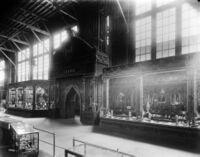
Block [62] - The Idaho booth featured peacocks made of grain.
Illinois[edit | edit source]

Blocks [47,48] - The Illinois exhibit featured corn that was worth $10 an ear, produced from the Otwell plan. A South American farmer offered $10 each, for the best 10 ears of corn. W. B. Otwell sent 500 grains of pedigree seed to 8,000 farm boys in Illinois, and 1,700 of them sent 10 ears each to Mr. Otwell to be placed in the exhibit. Corn from every county in the state was sent to be in the exhibit. A $3,500 premium was placed on the corn, and the farm boy with the best corn won $500. At the exhibit the 10 ears that each farm boy sent were in a stack with the his picture was on display in front of it. Mr. Otwell received many letters from farm boys that could not come to the fair with excuses such as, the mules got out and ate the corn or mother picked the wrong corn for roasting. Illinois was the only state that had a contest and exhibit of this kind.
Indiana[edit | edit source]
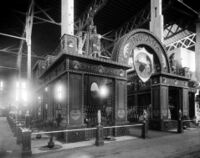
Block [41] - The Indiana exhibit featured the grains of that state.
Iowa[edit | edit source]
Block [59] -The Iowa exhibit featured a golden ear of corn with silver husks, silver cups, and other trophies. The golden ear was the prize for the best corn from an Iowa corn club. A corn club was made up of four neighboring farmers. Six ears of corn were picked from each club as an entry. The ears were judged at the farmers’ institute.
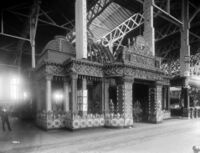
Iowa’s exhibit dealt with the introduction of creameries to the west and showed a model of the dairy school at the College of Agriculture at Ames, Iowa. It also showed a bust of John Stewart a pioneer in the dairy industry west of the Mississippi. It also included a model of the first creamery at Manchester, Delaware County, Iowa. The Forest City Series of 1904 showed the above photo and gave the following description:
IOWA’S CORN TROPHIES.—A central location in the Palace of Agriculture is occupied by the grain pavilion of Iowa, the primary purpose being to show the world the kinds of grain produced on Iowa’s soil and beyond that to inform visiting farmers of proper methods of cultivation. One of the exhibits in this pavilion is an average corn stalk with its roots permitted to extend over a radius of fully two feet. This is to teach the farmer the growth of corn roots when allowed to extend naturally and to show him that deep cultivation at the wrong time cuts off roots and restricts the later growth of the corn. Hundreds of jars of seeds show the almost bewildering variety of grains grown to perfection in the State of Iowa. In the pavilion are three notable corn trophies. One is a loving cup with a design in corn. Another is a silver and gold ear of corn that forms a vase. The third is an ear of corn made of silver and gold. These three prizes were offered for the three best entries of ten ears of corn each produced in the State. Iowa’s agricultural exhibit carries the artistic idea into the display of dairy products. A bust of John Stewart, the father of the modern creamery, is shown, modeled in butter. Beside the bust is a miniature reproduction of Stewart’s old dairy house, built by him in 1872, with a companion piece in the model dairy school at Ames, a branch of the Iowa College of Agriculture.
Kansas[edit | edit source]
Block [68] - The Kansas Display featured Wheat and other grains grown in Kansas. H. H. Kern, was Superintendent of the Kansas Exhibit and he wrote the following report that was published in the "Report of the Kansas World's Fair Commission":
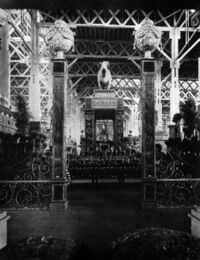
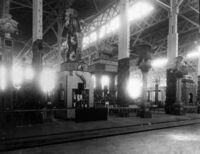
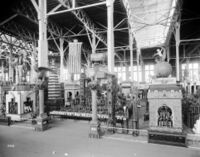
The Kansas Pavilion in the Agricultural Palace occupied a space assigned to Kansas, north and south 92' x 62', on the main aisle near the center of the building. Around the pavilion was a scroll-iron fence covered with chains of cane links festooned from pillar to pillar On each side were four pillars, 16' high, decorated with ears of corn and corn-husks. Upon each of these rested a Grecian vase made of corn-husks and festooned with rosettes and garlands of com-husks, being one of the most attractive, complete and instructive booths, with a view of showing her numerous products to the best advantage. Every design had a meaning, representing all the- products of the State. The noted Kansas corn-steer, eagles, colossal Indian, decorating of the outside of the four booths with artistically arranged corn-husks, the globe, cornucopia, and Cupid, were designed and executed by Mr. 0. H. Kassebaum, of Atchison. The decorations were unique and artistic, and entirely different from any other exhibit. The figures were new in design, novel and attractive, and the workmanship of the artists constructed entirely of the numerous grains, grasses and cereals of the State, including nearly every product grown on the fertile fields of the State.
Standing at the main entrance between the two high corn columns rested two eagles with wings spread for flight, one made of corn-husks and kernels of corn, the other made of wheat-straw and kernels of corn, were the work of an artist, and the best pieces of workmanship in their line exhibited at this or any other exposition.
Suspended above and between the two eagles was a 14-foot American flag, a most artistic conception, the stars and stripes made of corn-husk?; dyed red, white and blue, made by the Atchison County High School girls. At the south entrance of the pavilion stood an obelisk pyramid made of wheat-heads towering BO feet high, upon which rested a large sheaf of wheat, 6 feet high, the base standing 6 feet high, and at the top of base was inscribed in wheat-heads, " Kansas, the Banner Wheat State."
One of the most striking features one noticed was the large center pyramid surmounted by a monster steer of the Hereford type, 7 feet in height, fashioned of red and white shelled corn. At the top of this pyramid the, word:" Kansas " was worked in corn. The four large columns supporting the steer were built of plain pine boards, covered with red cloth; this made an excellent background, and showed to advantage the various grain and grass decorations of stars and maltese crosses. Above the pedestal of the center booth was an open pavilion, containing a large bouquet of native tame and ornamental grasses; around this on the four sides were placed large glass jars filled with wheat, oats, barley, rye, flax, grass seeds, etc. Sheaves of wheat, rye, oats, barley, millet, tame and ornamental grasses tied with ribbons were conspicuous over the various glass jars of seeds and grasses.
The four portieres made of various colors of corn kernels, draped from the top to the bottom of the pavilion. Around the base on four sides were grains and grasses in sheaves of every description fastened upon the walls. Just above the base a shelf two feet high contained grains, grasses, field and garden seeds in glass jars, each jar and sheaf having a label giving the name of the exhibit, name and address of grower, the yield per acre, and the test weight.
In each corner of the exhibit stood a booth. On No. 1, in the southeast corner, towered a gigantic Indian fifteen feet high, his face and hands made of plaster of Paris, covered with shelled popcorn, his Navajo blanket, a piece of fine workmanship in woven corn-husks, his feathers made of corn-husks, his quiver of cornhusks, his shield of various beautiful-colored corn, - all showing what can be achieved with kernels of corn and cornhusks, this being the only material used. The top of this was finished with cornstalks; the base was covered with plaited cornhusks; each booth contained four windows. The windows of this booth were square, and finished with rows of red and white corn. Above the windows was -one mass of ears of red, yellow and white corn. In the northeast corner of the exhibit stood booth No. 2, the base being covered with wheat-straw; over this, links of red corn. The center portion of the booth was covered with wheat-straw blocked in corn-stalks. There were four arched windows in this booth finished with rows of white, red and yellow corn. This booth was surmounted by a large globe and a cornucopia of Plenty, from which showers of wheat continually fell on the, earth of wheat, signifying that Kansas supplies the world with wheat.
In the southwest, corner of the exhibit was booth No. 3, covered with pointed puffed corn-husks, a very beautiful design; the base was covered with corn-husks, block-work trimmed with ears of corn, with four arched windows of ear-corn. This booth was surmounted by a large terra-cotta vase filled with a bouquet of native and ornamental grasses.
In the northwest corner stood booth No. 4; the lower base was wheat-straw trimmed with red corn; four large columns covered with corn-husks resembling oval-shaped shingles, top decorated with ear and shelled pop-corn festooned in corn-husks and corn-husk ribbons.
In the center of each booth was a pyramid covered with red cloth, with shelves. On the shelves extending around the pyra- mid were placed glass jars containing wheat, corn, oats, barley, flax, buckwheat, clover, alfalfa and timothy seeds; they repre- sented the best of each kind that could be found, each having been tested before being placed on exhibition.
There were four large pillars on the east side and four on the west side of the center pavilion, 16 feet high and 4 feet wide, covered with green cloth as a background; The exhibits of grain grasses, cane, corn-stalks, Kaffir corn and alfalfa were tied with red and blue silk ribbons and fastened in their position,—each side containing a different kind of grain or grass or other cereal in sheaves.
The background of green, and the grains and grasses tied with blue and red silk ribbons, made a very harmonious effect. At the north entrance stood-a pyramid of native grasses, upon which a vase made of oat-heads, seven feet high, rested. Directly opposite stood a pyramid of tame grasses, upon which rested a vase made of the heads of grains and grasses, seven feet high.
On the south entrance stood two pyramids of different kinds of grains, wheat, barley, flax, speltz, rye, and oats. Upon one of these rested a column of oats twelve feet high; upon the other a column of wheat. These pyramids were covered with a red cloth for background, each sheaf trimmed with blue ribbon. Midway between the central pyramid and the entrance on the east, west and north sides stood twenty tables on which were field and garden seeds, and 150 exhibits of numerous varieties of corn.
The Kansas State Agricultural College, at Manhattan, exhibited alfalfa, corn, cane, Kaffir corn, oats, buffalograss, and big bluestem grass, showing the plant and root growth. Besides these, twenty-five varieties of wheat-sheaves, ten varieties of cane, fourteen feet in length; four varieties of Kaffir corn; three of broom-corn, fifteen feet; and stalks of corn, sixteen feet high; millet, six feet.
State Agricultural College Experiment Station, Hays, Kan., collection of wheat, rye, barley, speltz, oats, flax.
Kentucky[edit | edit source]
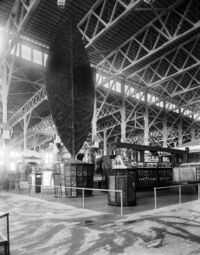
Block [120] - Kentucky's Display was made of grains and some tobacco. Kentucky displayed an obelisk, 12' high, made of blue grass from the experiment station. The state showcased 4,628 square feet for its tobacco display with 232 exhibitors. The state also showcased its production of corn and hemp (Kentucky produced more than 90% of US hemp at the time).
Louisiana[edit | edit source]
Block [102] - A 40 pound sweet potato from the Louisiana exhibit was displayed in the Palace of Agriculture. The sweet potato was a Chinese yam that was raised in Louisiana in order to fatten up hogs. It was a leafless vine that had lots of blooms on it at the time. The vine that sprouted during the World’s Fair was 40 feet long wrapping around the walls of the exhibit. Supports were provided for the vines. It brought in many spectators.
Louisiana also proudly displayed exhibits of rice, cotton and 2,000 feet of space, solely devoted to over 100 varieties of sugar cane.
Mississippi[edit | edit source]
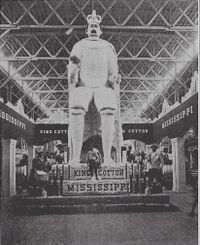
In the center of the cotton section was Mississippi’s statue of King Cotton. It vied for attention against Indiana’s King Corn statue. They were both magnificent eye catching figures. At King Cotton’s feet were “two life-sized figures of negro cotton pickers with half filled baskets.” King Cotton was made entirely of cotton.
Missouri[edit | edit source]
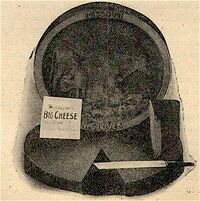
Blocks [63, 64, 65, 66, 78] - Missouri’s cheese exhibit was a one of a kind display of a full cream cheese block that weighed over 3,000 lbs. The block was so massive it took ten men to unload it from the train into a case, and four horses hitched to a wagon with the case to pull it to the Agriculture building. The cheese was made in Altamont, MO in Daviess county. Molded to the front of the cheese was a milking cow in a pasture of clover with a young lady on a stool milking the cow. It took 3,000 milking cows to produce the 35,000 lbs of milk, which was purchased from 150 dairymen, needed to make the block of cheese. The cheese was displayed in the original hoop that it was pressed in, in a case that was exactly like the butter case, and the temperature was held from 35 to 40 degrees.
The Missouri butter exhibit was regarded as one of the prominent attractions and many people expressed that their entire trip was compensated for with this exhibit alone. The Missouri Commission spent ten thousand dollars on this exhibit alone so the magnitude of this impressive project equaled the workmanship of the sculptor.
The central figure in the exhibit was Ceres, the Goddess of Agriculture holding a sickle in her hands, then on either side of her was a model of a dairy cow. The one on the right represented the Jersey breed and was modeled off of a famous cow owned by a Dr. Still of Kirksville Missouri. This cows head and neck was shown resting on a sheaf of wheat with her nose in the lap of Ceres. The cow on the left was a representation of a champion Holstein owned by M.E. Moore of Cameron Missouri. This cow was in a test at the worlds fair and produced 270 lbs of butter in ninety days. Both owners pronounced the likenesses a perfect rendition of their animals.
On the walls surrounding the central exhibit a story was portrayed in solid butter starting at the left was a figure of a woman churning with an old fashioned churn. Then in the next corner was a woman skimming a pan of milk on which the cream had raised by the old gravity process. Between the two on the floor of a scantily furnished log home was a boy feeding his dog. This represented the old methods. To the right of this at right angles was a mother playing with her children while a boy separated the milk with a centrifugal separator. This represented the new method. Around the corner from this was a reproduction of the seal of the state of Missouri. All of this was done in solid butter.
The entire exhibit was made of pure solid butter, 3,000 pounds worth of butter to be exact. To make 3,000 pounds of butter required 75,000 pounds of milk or 9,000 gallons this is equal to an average milking from 6,000 cows. The space occupied by the exhibit was eight feet by twenty-eight feet, making 224 square feet of floor space, and about 325 square feet of wall space. All of this was inside a refrigerated case with a glass front of three thicknesses of plate glass with airspace between each
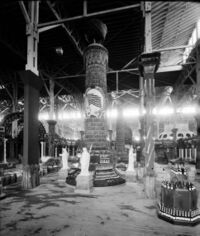
An attraction that drew crowds to the Missouri exhibit was the corn towers. There were two 38' tall towers with a 45' replica of the Louisiana Purchase Monument at their center. The monument displayed two flags; the American flag and the Louisiana Purchase Emblem, both made of naturally colored corn shucks and leaf blades.

A fourth tower, which was an actual building, was often referred to as “the corn temple”.
It was 65' tall with a dome at the top that reached 125' in circumference and had a large bronze colored ear of corn extending 10' from the top of the dome with a circumference of 12'. The temple used 1,000 bushels and consisted of fifty different shades of corn and was often used as a lounge and a meeting place.
Two features of the Missouri exhibit in the Palace of Agriculture were life-size figures of a Missouri woman and Indian maiden. Both costumes were constructed entirely of corn and carried out in the minutest detail the garments of the era indicated.

The Indian maiden’s costume was made of corn husks and hung from her shoulders straight except for a belt composed of many-hued kernels of corn. In lieu of buckskin and beads the moccasins were made from husks and corn kernels, while her hair was constructed of corn silks. The maiden’s necklace was constructed of pearly-hued popcorn.
The Missouri girl’s gown was composed of corn, the coiffure crowned with popcorn. The bodice was cut low and made of husks, and her necklace was made of corn kernels. The Eton jacket was embroidered with white and red clover seed. The skirt was finished with fringe made of corn silks and millet tassels. The train of the skirt was also embroidered of clover seed matching that on the Eton jacket. The corsage bouquet, manufactured of corn husks completed the costume.
Being the host state, Missouri put on quite a show in its five block exhibit. It was by far the most impressive in the Agriculture Palace, and rightfully so considering the $100,000 allocated by the state for the display. One of the most impressive features of the exhibit were two immense 15 by 35 foot murals on the west wall. One depicted a 6,000 acre corn field in Atchison County owned by David Rankin. Click here to learn more about David Rankin.
The murals were made entirely of grain and grasses. Much of the grain, especially corn, had been collected throughout the state at county corn shows that were held for the sole purpose of finding premium corn; and a premium price was paid by the Missouri Commission for the corn. The murals were constructed by a French Canadian artist from Toronto named J.D. Fortier.
Minnesota[edit | edit source]
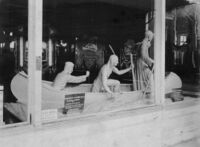
Minnesota exhibited a refrigerated nine by twenty foot butter sculpture of Father Hennepin's discovery of the St. Anthony Falls.
Nebraska[edit | edit source]
Block [57] - The Forest City Series of 1904 gave the following description of Nebraska's exhibit:
NEBRASKA'S MONUMENT TO MAIZE.-Two pavilions are devoted to the display of Nebraska's products in the Palace of Agriculture. One of them is among the most notable of the installations; it is a monument to maize fairly well represented by the picture. A tall shaft rises from an open vaulted base which forms a small reception room. Base and shaft are covered with ears of corn arranged tastefully. Through utilization of the different colors of the grain and by employment of the varying sizes from popcorn to field corn the monument is made a work of art as well as of ingenuity. A globe rests upon the apex of the shaft while perched upon that is the gilded eagle. The other pavilion of Nebraska glorifies some things besides corn. It shows the small grains and grasses. In the midst of the bewildering array of productions of the soil stands the monarch of all he surveys, mounted in lifelike form, the steer which was the champion of the world in the International Livestock Show of 190 - a blue-gray cross bred animal of enormous weight. Nebraska maintains in the center of this booth a theatre with stage and moving pictures of actual farming scenes in the State. There, hour after hour, thousands of visitors saw Nebraska's farmers plowing and sowing, cultivating and reaping, stacking and branding.
The Nebraska exhibit featured the grains of that state.
New York[edit | edit source]
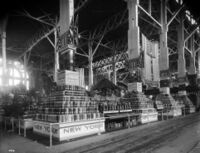
Block [76] - The New York exhibit in the Palace of Agriculture was elaborate in that it featured all 45 vegetables known to the field of Agriculture and featured many varieties of each vegetable. Two train carloads were needed just to bring the vegetables from New York and a third of the states exhibit section was taken over by the vegetables. One of the features of the exhibit was a 20 foot wide and 15 foot tall pyramid made of pumpkins and squash that contained 60 varieties and size variations from 135 pounds to a few ounces and the overall weight of the pyramid was over 4 tons.
The exhibit also featured 400 potato varieties, 27 types of peppers, 5 cabbage varieties and 6 types of eggplant. All the groups were stacked in pyramids to show variations in color and sizes.
During the period of the World’s Fair, New York constantly replenished the parts of the vegetable exhibit which contained perishable vegetables. The varieties that were not perishable were to be given to charitable institutions in St. Louis once the fair was over.
New York also included an eighteen foot lighthouse made from salt.
North Carolina[edit | edit source]
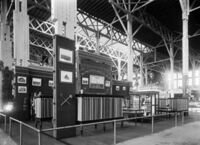
Block [50] - In 1904, North Carolina produced one-third of the peanuts consumed in the world, which was why peanuts had such a prominent place in the agricultural exhibit of the state. The exhibit showed seven different varieties of this important crop of North Carolina. Peanut production gave employment to thousands of people. The state also excelled in the production of peas and thirty-two varieties of peas were on display.
Oklahoma[edit | edit source]
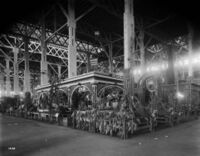
Block [42] - The Oklahoma exhibit in the Agricultural Palace displayed samples of that years corn crop that had been harvested on July 22. It was a ninety day corn called Red King. Also on display were the second cutting of alfalfa and red clover from the state.
The exhibit also included a demonstration of processing cotton. The display took fair goers from the field to the cotton gin, showing the seed being separated from the cotton, then ground and separated from the hull which was used as a forage. The viewer then saw how the seeds were pressed and made into cooking oil. Crude oil from the process was used in making soap.
Oregon[edit | edit source]
Block [102] - Oregon had one of the most intriguing displays compared to many of the other states. They had an alfalfa demonstration showing that five cuttings of a single alfalfa plant were measured to be 10 feet tall.
Texas[edit | edit source]
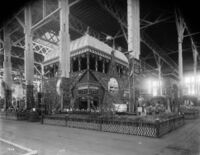
Block [85] - The Texas Star made of grain was featured in the Texas booth. A sign on the column appears to say "Wise Men of the East follow the Star to Texas."
In the Agriculture Palace, the state of Texas had maintained its reputation for growing fruits and crops of giant size. The exhibit displayed a watermelon of enormous size weighing in at 97.5 pounds. On display were forty seven ears of popcorn that came from nine stalks. Also, there was one stalk of ordinary corn that had reached the height of twenty feet with seven foot long roots and was not finished growing.
Sumatra wrapper tobacco that was successfully grown in Texas was on display in the Texas booth. This tobacco was characterized by its very thin and silky texture. The leaves of the plant were so thin that it took 500 leaves to weigh a pound. Grown under a huge tent in the southern part of the state, and supervised by a government expert, it was demonstrated that Texas’ climate conditions were similar to that of Sumatra. A few of the other states have tried to produce the tobacco with artificial shade under the government’s supervision but it was thought that these plants were not as good.
Virginia[edit | edit source]
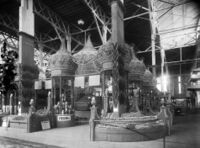
Block [120] - In the Virginia section of the cotton exhibit was a lighted fountain that did not splash. That was because the fountain was made with cotton seed oil, not water. Around the fountain jars were filled with different soaps made from cotton seed oil. There was also a demonstration area showing the value of the oil in foods. Also demonstrated was the value of the oil in livestock feeds and fertilizers.
Washington[edit | edit source]
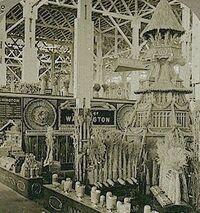
Block [60] - The Washington booth in the Agricultural Palace featured grains of the west.
Wisconsin[edit | edit source]
Block [30] - The Wisconsin exhibit featured a display on the Babcock milk test. Professor Babcock and his work was claimed to save Wisconsin dairy farmers $800,000 ($24.1 million in 2021) a year due to his scientific processes incorporated into milking. An example of his test showed that out of 11 herds producing No. 1 quality milk for Swiss cheese production, 1 cow with a hoof disease, lowered the milk quality to No. 2, which was losing money for all farmers. Thru the Professor's curd test, the herd was segregated as the problem and then the one cow was found and taken out of the milking herd, all of which made for more profit for the farmers and the cheese maker.
Foreign[edit | edit source]
Argentina[edit | edit source]
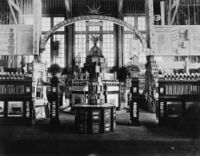
Block [125] - The booth told about the crops and livestock from Argentina. The posters in the upper part showed increases in exports of Argentine Agricultural products. The Argentine Republic was reputed to be the greatest producer of wool in the world, and showcased the Merino and Lincoln sheep. On display was magnificent collection of sheepskins. They also showed off their dairy industry and exhibited natural milk and dairy technology and modernization.
Canada[edit | edit source]
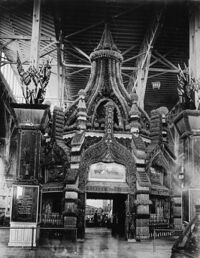
Blocks [111,112] - Canada's Display featured both the crops and animals of the various provinces.
A white cucumber was exhibited in the Palace of Agriculture. This variety was bred from the White Spine cucumber. The seeds were saved with intentions to preserve this specimen. It was discovered at the Brandon, Manitoba, experimental farm.
The Forest City Series from 1904 gave the following description:
THE LIBRARY OF PARLIAMENT IN GRAIN.— No part of the world has made a stronger demonstration of its agricultural possibilities than has Canada at this Universal Exposition. The picture shows the arrangement of three thousand specimens of grains and grasses worked into a replica of one of the most handsome and most noted of Canada’s public structures—the Library of Parliament at Ottawa. Buttresses are built of millet. Into the decorations enter brome grass, a fodder crop grown in western Canada, appearing soon after snow leaves the ground. Wheat, oats, clover, blue grass, amid hundreds of other products of the soil contribute to the construction and covering of this octagonal building with spire extending sixty feet, almost to the girders of the Palace of Agriculture. Corn, the grain so conspicuous in the exhibits of the States, is wanting. The Canadian season forces growth but is too short for the maturing of maize. In the eight arches of the Octagon are large oil paintings illustrating as many branches of the live stock industry of Canada. Windows under the pointed arches are filled with bottles of grain. The interior walls of the octagon are lined with agricultural specimens. At the corners of Canada’s space are little booths each serving to impress in effective manner some agricultural industry.
Ceylon[edit | edit source]
Block [126] - Ceylon had exhibits throughout the fairgrounds. This is their exhibit in the Palace of Agriculture.
France[edit | edit source]
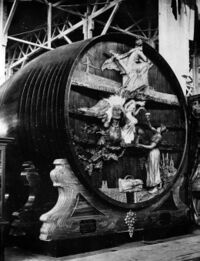
Blocks [134, 135, 136, 137, 145, 146, 147, 148, 149] - When entering the Palace of Agriculture, just to the left from the north entrance was the French exhibit. A huge cask, gigantic in size, caught visitors’ eyes. When you talk about a cask, the size is often like that of 50 or 60-gallon barrel. This cask had the capacity of 17,225 gallons, which was nearly enough to fill half a small standpipe. Plus to everyone’s amazement the cask was filled with champagne.
The actual measurement of the cask was seventeen and one-half feet in diameter and a little over seventeen feet long. One of the more interesting things connected with the exhibit was the construction of the great vacuum. The staves were five inches thick, made of white oak. The head was four inches thick, of Hungarian oak. The front head of this great Ring of Barrels was ornamented with costly hand carvings from hardwood, life-size images of humans, symbolizing France treating America to a glass of champagne.
The handiwork was done by Mr. Emile Galle of Nancy, France. The casks were made in different sizes, from the size of a jug to the one described above who were made by Tonnellerie & Fruhinsholz, of Nancy, France. The champagne distillers Veuve Pommery Fils & Co., of Reims, France bought almost the entire product of casks that were manufactured for the World Fair.
Germany[edit | edit source]
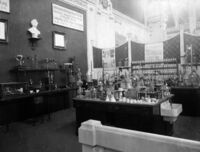
Blocks [116, 117, 118, 129, 130, 131, 132, 133] - The German exhibit had an extraordinary display of food products, preserves, wine, and liquors. A complete laboratory was present for the chemical analysis of all foods, wines, liquors, and waters were evaluated. In the center of the section was a large fountain of Rheingold and paintings of Frankfort-on-the-Main, the old City hall of Munich, and scenes along the Rhine River which decorated the walls. All visitors to this section received a German luncheon.
New Zealand[edit | edit source]
Block [97] - New Zealand’s feature at the World’s Fair was wool. New Zealand’s wool and products manufactured from the wool formed a beautiful display in the Palace of Agriculture. The display showed blankets and rugs of finest weave, texture, and coloring. New Zealand and Australia exhibited twine made from hemp of their own production.
New Zealand claimed that the climate and soil in their country produced wool superior to any in the world. The articles manufactured from the wool were to have a softness and quality possessed by none other. There were twenty million sheep in the country at the time and the annual output from these sheep was valued at $30,000,000 ($905 million in 2021).
Companies[edit | edit source]
Avery Manufacturing Company[edit | edit source]
Block [24] - Headquartered in Minneapolis, Minnesota, Avery Manufacturing Company displayed threshing outfits, cultivators, and corn planters. Mr. E.W. Langer, the Midwestern representative, was in charge of the exhibit. He performed daily operations of the threshers and planters in order to demonstrate the many features of the machines.
A display of a “fireproof” wagon made of nine-tenths of iron was also shown. The display included the construction of every step in making it provided by Bettendorf Axle Company.
Eskay[edit | edit source]
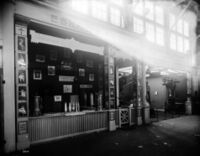
Block [71] - In the Agricultural Building, another phase of Eskay’s Food’s usefulness was shown. In their booth, lined with pictures of laughing plump children, Messers, Smith, Kline and French serve Eskay’s Food as prepared for adults. It had a wonderful up building effect on grown people, and was often prescribed for the convalescent, the weary, the aged, and for those who wished to gain weight.
Eskay’s Food was composed in part of wheat, barley, and oats, carefully selected, and so prepared as to act as an attenuate of the tough, cheesy curds which are found in cow’s milk, and to change them into smooth and flocculent curds, the same as found in mother’s milk. Then the manufacturers added the egg in combination with sugar of milk, which latter preserves it, and this so finely powdered as to be readily held in suspension and easily acted upon by the fluids of the stomach. This, together with the sugar of milk, supplies a modifier of cow’s milk, furnishing the tissue building element, and the heat and energy producing element in such proportions as to supply perfect nutrition, not only for the infant, but for the invalid.
One need but to compare this food with the other infant and invalid foods served at the World’s Fair to detect its superiority. If any further evidence of its adaptability for the purpose for which it is recommended were needed, it is furnished in the pictures of actual Eskay’s Food babies shown in the booth, representing the results of its use in well fed, well nourished, and perfectly healthy and happy babies.
Heinz[edit | edit source]
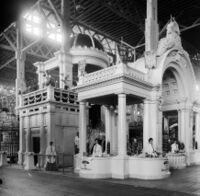

Block [108] - Sharing space with Connecticut, was a beautiful gold-and-white pavilion from Heinz 57. It was easy to find the Heinz booth due to fact that the booth featured a pickle outlined in light bulbs cheering “57”. The sign welcomed the visitors who came to see the twenty two acres of food products in the Agriculture Palace. Below the sign were four revolving pyramids of Heinz products that were turning with 200 light bulbs shining on them. There was a fifth pyramid in the center of the booth that was stationary, which the other pyramids revolved around. At the exhibit, products of Heinz were served as samples and souvenirs were given out. Many visitors took interest in the colored stereopticon views which were shown in the little auditorium below the tower at the pavilion.
The Heinz 57 Company had “mini sections” located in ten different state booths that showed what each state produced for the Heinz Company. The states ranged from New York, in the east, Iowa, in the west, and Virginia, in the south.
Janesville Machine Co[edit | edit source]
Block [7] - A potato digger on display was a hit among the farmers. Also displayed was the caretaking equipment of the fairgrounds. The Hallock Cultivator and Hallock Weeder were just a few of the items used on the lawn and garden beds.
J. I. Case Threshing Machine Company[edit | edit source]
Block [20] - J. I. Case Threshing Machine Company exhibited a threshing machine separator. It was made of mahogany wood that was imported especially for this exhibit. The machine was in operation during the fair, and the parts were visible through a beveled glass covering.
Midland Manufacturing Co[edit | edit source]
Block [4] - Midland Manufacturing Co., Tarkio, MO. was a plow company owned by David Rankin, who had more farmland than anyone in Missouri.
National Dairy Machine Company[edit | edit source]
Block [52] - The National Dairy Machine Company exhibited several hand operated cream separators that were invented by Mr. Oscar Anderson who was also VP of the company.
Pillsbury-Washburn Mills Company[edit | edit source]
Block [121] - Located in the same block as Spain, was a flour mill operation from Pillsbury-Washburn Mills Company in Minneapolis, Minnesota. The process of wheat growing, flour making, and bread baking were all demonstrated. Photographs of the wheat, wheat machinery, harvesting, soil keeping and grain threshing were also displayed in the exhibit. The history of the mill was also demonstrated through pictures. A freight train loaded the products from the mill and was run through mixers into dough, and then electric ovens. It was then was baked and sampled. There was a case divided into eighty compartments that demonstrated various milling separations from the time the wheat left the field until it became flour.
St. Charles Condensing Company[edit | edit source]
Block [55] - In a corner booth at the Agriculture Palace stood a golden cow. This golden cow was the trademark of the St. Charles Cream. This cow is meant to bring peace and comfort unlike the golden calf of the bible which brought trouble and discord. The white-and-gold booth was decorated with pyramids of cream cans and many tiny statues of the golden cow.
Cream would be served at the counter in little glasses and there would be puzzles given to the children for entertainment. While a person tasted the cream, one could admire the various awards and honors received by the St. Charles Cream.
The cream was recommended by nurses and doctors for children to drink. All that needed to be done to the cream was add water and it would become fluid milk. This was supposed to safer than ordinary milk out of the cow because the cream had been sterilized. Sterilization killed tuberculosis and many other diseases. The cream provided an alternative to ordinary milk for children who would get upset stomachs caused by the milk. The St. Charles Cream has been used for many years at the Chicago Foundlings’ Home and has had great results from it.
For cooking, the cream is said to preferable because it is pure unlike ordinary milk or cream. The cream was nice for custards, puddings, soups, ice cream, and confectionary. Obviously, the cream had an everyday use in tea, coffee, cocoa, and toppings for fruits. The cream was unsweetened and replaced fresh milk or cream for drinking and cooking. The cream was a convenience to many, because it was in a can be stored in the pantry and did not have to wait on the milk man to begin your cooking.
The St. Charles Cream was prepared from milk produced by selected cows, which were scientifically fed on outstanding farms. The farms were located from St. Charles, Illinois to Ingersoll, Ontario. The farms were under direct supervision from the company’s inspectors and much care would be taken at every step. The milk would be reduced to the consistency of cream by evaporation, and then it would be canned and preserved by a process of sterilization.
Standard Guano and Chemical Company[edit | edit source]
Block [25] - Even before the 1904 World’s Fair in St. Louis began, the Standard Guano and Chemical Company of New Orleans had been in existence for around 30 years. It had experienced success in making special fertilizers to fit the special needs of farmers of the southern and Midwest parts of the U.S. and the company carried an excellent reputation of using sound scientific methods and dealing fairly with its’ customers. The success of the Guano Company was obvious as the company had a plant that covered 20 acres of land in New Orleans. The company’s pavilion at the 1904 World’s Fair Palace of Agriculture was designed to exhibit their special fertilizers for a specific purpose and also show off their general fertilizer lines that were more applicable to many of the farmers of the time. In addition to this, the company also had a system where the buyer could buy several general types of fertilizer materials and custom blend their own mixtures.
The company had a research base that believed combinations of animal bone and animal matter gave them the best possible and field tests proved this. A clipping from the Farmers’ Hand Book, which the Guano company published stated how their product permanently enriched the soil, made for rust and blight resistance, made plants more insect resistant, and makes for higher yielding crops.
Some of the special fertilizer blends were made for: cotton, sugar cane, oranges, rice, cabbage, tobacco, strawberries, nursery plants and onions. The raw materials the company used most commonly were animal blood, bone meal and the meat guano (scraps). These materials were easily and cheaply attained from the cattle industries of Texas and the western U.S. and also South and Central America.
The products of the Standard Guano and Chemical Mfg. Company had won awards for it’s products at the 1884 World’s Centennial Cotton Exposition and the 1885 North, Central, and South American Cotton Exposition.
The Syracuse Chilled Plow Co[edit | edit source]
Block [6] - The Syracuse Chilled Plow Co., Syracuse, N. Y. display had elegant wall mirrors and Brussels carpet that added to the appearance of the display. Its display was painted and decorated so that it received a lot of attention from fairgoers.
Walter-Baker[edit | edit source]
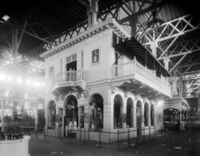
Block [103] - Walter Baker Company If you visited the Exposition, you would have found a building in pure Colonial style, two stories high. It was a full size replica the home of Walter Baker Chocolate. Within the building at one side of the entrance was the exhibition room, where the various chocolates and cocoa made by this well-known firm were shown and sold. In large glass jars were displayed the raw material from which these goods were made, beginning with the great cucumber-shaped cocoa pods, and continuing through the beans, shells, cracked cocoa, and the cocoa butter, down to the finished products-the finely powdered cocoa, and the chocolate unequaled for smoothness, delicacy, and flavor. Large bags of the different varieties of cocoa beans were also shown.
At the left of the main doorway was the lecture-room, where Miss Burr, of the Boston School of Domestic Science, lectured each day on scientific cookery with chocolate.

The feature that attracted the most attention was the complete working-model of the chocolate machines shown in the center of the main floor. This model, made in Germany specifically for this Exposition, was run by its own little motor, and showed the process of chocolate making from the time the raw beans come into the factory. First, was the roaster, then the winnowing machine, in which the husks were removed, the grinders which reduced the beans to a semi-liquid state, the melanger, and the rollers. The noisy little shakers jolted the soft chocolate into shape, and the bolter drove the cocoa through the fine cloth until it reached the evenly powdered condition.
Located on the second floor was a serving room, where Baker’s vanilla chocolate and cocoa were served. A genuine antique was the mahogany clock at the head of the stairs. This clock was 150 years old, and made on the Island of Jersey. In one corner of the second floor was the kitchen run by a man named Ben who had been with the company for 12 years.
The Walter Baker chocolates were produced in Dorchester on the banks of the Neponset River since 1780. Walter Baker chocolate and cocoa was said to have set the standard for genuine worth and purity, a reputation which was well maintained at the Louisiana Purchase Exposition.
